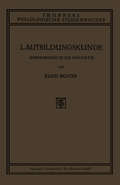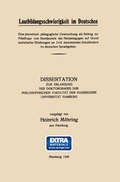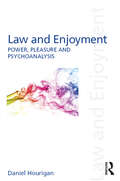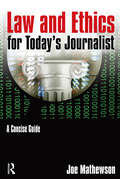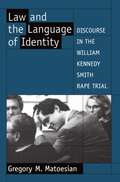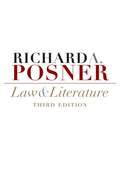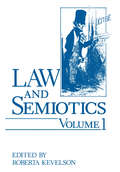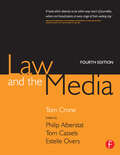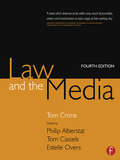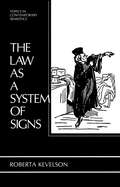- Table View
- List View
Laurence Sterne and the Visual Imagination
by W.B. GerardThe first full-length and comprehensive study of the illustrations of Sterne's work, this book explores the ability of Sterne's texts to inspire the visual imagination. It helps to explain why scores of editions of his fiction have been illustrated, some profusely: to fulfill the reader's desire, as well as the artist's compulsion, to visualize Sterne's words. Gerard places his subject in a clear and innovative theoretical framework which opens the field to general word and image studies. The author begins by examining the distinct varieties of pictorialism in Sterne's texts. The remainder of the study takes into account three remarkable series of illustrations-representing Trim reading the sermon, didactic sentimentalism in A Sentimental Journey and Henry Mackenzie's Man of Feeling, and the many and diverse portrayals of 'poor Maria' - to demonstrate the ways in which culture projects these texts differently through the various artists.
Laurence Sterne and the Visual Imagination
by W.B. GerardThe first full-length and comprehensive study of the illustrations of Sterne's work, this book explores the ability of Sterne's texts to inspire the visual imagination. It helps to explain why scores of editions of his fiction have been illustrated, some profusely: to fulfill the reader's desire, as well as the artist's compulsion, to visualize Sterne's words. Gerard places his subject in a clear and innovative theoretical framework which opens the field to general word and image studies. The author begins by examining the distinct varieties of pictorialism in Sterne's texts. The remainder of the study takes into account three remarkable series of illustrations-representing Trim reading the sermon, didactic sentimentalism in A Sentimental Journey and Henry Mackenzie's Man of Feeling, and the many and diverse portrayals of 'poor Maria' - to demonstrate the ways in which culture projects these texts differently through the various artists.
Lautbildungskunde: Einführung in die Phonetik (Teubners philologische Studienbücher)
by Dr. Elise RichterDieser Buchtitel ist Teil des Digitalisierungsprojekts Springer Book Archives mit Publikationen, die seit den Anfängen des Verlags von 1842 erschienen sind. Der Verlag stellt mit diesem Archiv Quellen für die historische wie auch die disziplingeschichtliche Forschung zur Verfügung, die jeweils im historischen Kontext betrachtet werden müssen. Dieser Titel erschien in der Zeit vor 1945 und wird daher in seiner zeittypischen politisch-ideologischen Ausrichtung vom Verlag nicht beworben.
Lautbildungsschwierigkeit im Deutschen: Eine phonetisch- pädagogische Untersuchung als Beitrag zur Fibelfrage vom Standpunkte des Heilpädagogen auf Grund statistischer Erhebungen an 2102 stammelnden Schulkindern im deutschen Sprachgebiet
by Heinrich MöhringDieser Buchtitel ist Teil des Digitalisierungsprojekts Springer Book Archives mit Publikationen, die seit den Anfängen des Verlags von 1842 erschienen sind. Der Verlag stellt mit diesem Archiv Quellen für die historische wie auch die disziplingeschichtliche Forschung zur Verfügung, die jeweils im historischen Kontext betrachtet werden müssen. Dieser Titel erschien in der Zeit vor 1945 und wird daher in seiner zeittypischen politisch-ideologischen Ausrichtung vom Verlag nicht beworben.
Lauterkeitsrecht und Acquis Communautaire (MPI Studies on Intellectual Property and Competition Law #14)
by Reto Hilty Frauke Henning-BodewigDas Recht zur Bekämpfung unlauteren Wettbewerbs ist in vielen europäischen Ländern ein eigenes Rechtsgebiet. Aus genuin nationalem Recht ist jedoch im Laufe der Zeit zunehmend europäisches Recht geworden. Andererseits ist es bisher nicht gelungen, ein einheitliches europäisches Lauterkeitsrecht zu schaffen. Die Autoren zeigen die Gründe dafür auf und beleuchten spezielle Fragen in rechtlicher und wirtschaftlicher Hinsicht. Der Band versteht sich als Beitrag zu einem künftig systematisch und kohärent ausgerichteten europäischen Lauterkeitsrecht.
Law and Chance
by Emanuele SeverinoWritten by one of the foremost Italian philosophers of the 20th century, Emanuele Severino's Law and Chance (Legge e Caso) explores how the concept of laws and legality push against the freedom to think freely and radically. Severino is increasingly being recognised as a truly foundational thinker in the formation of contemporary theory and his nuanced concept of legality explored in this work has particular relevance for issues around protest, police power and the role of personal conscience in how to live.The first English translation of this important work, Law and Chance is crucial reading for anyone engaged with the intersection between the law and personal freedom.
Law and Chance
by Emanuele SeverinoWritten by one of the foremost Italian philosophers of the 20th century, Emanuele Severino's Law and Chance (Legge e Caso) explores how the concept of laws and legality push against the freedom to think freely and radically. Severino is increasingly being recognised as a truly foundational thinker in the formation of contemporary theory and his nuanced concept of legality explored in this work has particular relevance for issues around protest, police power and the role of personal conscience in how to live.The first English translation of this important work, Law and Chance is crucial reading for anyone engaged with the intersection between the law and personal freedom.
Law and Enjoyment: Power, Pleasure and Psychoanalysis
by Daniel HouriganThis book advocates, and develops, a critical account of the relationship between law and the largely neglected issue of ‘enjoyment’. Taking popular culture seriously – as a lived and meaningful basis for a wider understanding of law, beyond the strictures of legal institutions and professional practices – it takes up a range of case studies from film and literature in order to consider how law is iterated through enjoyment, and how enjoyment embodies law. Drawing on psychoanalytic theory, this book addresses issues such as the forced choice to enjoy the law, the biopolitics of tyranny, the enjoyment of law’s contingency, the trauma of the law’s symbolic codification of pleasure, and the futuristic vision of law’s transgression. In so doing, it forges an important case for acknowledging and analyzing the complex relationship between power and pleasure in law – one that will be of considerable interest to legal theorists, as well as those with interests in the intersection of psychoanalytic and cultural theory.
Law and Enjoyment: Power, Pleasure and Psychoanalysis
by Daniel HouriganThis book advocates, and develops, a critical account of the relationship between law and the largely neglected issue of ‘enjoyment’. Taking popular culture seriously – as a lived and meaningful basis for a wider understanding of law, beyond the strictures of legal institutions and professional practices – it takes up a range of case studies from film and literature in order to consider how law is iterated through enjoyment, and how enjoyment embodies law. Drawing on psychoanalytic theory, this book addresses issues such as the forced choice to enjoy the law, the biopolitics of tyranny, the enjoyment of law’s contingency, the trauma of the law’s symbolic codification of pleasure, and the futuristic vision of law’s transgression. In so doing, it forges an important case for acknowledging and analyzing the complex relationship between power and pleasure in law – one that will be of considerable interest to legal theorists, as well as those with interests in the intersection of psychoanalytic and cultural theory.
Law and Ethics for Today's Journalist: A Concise Guide
by Joe MathewsonLaw and Ethics for Today's Journalist offers aspiring and working journalists the practical understanding of law and ethics they must have to succeed at their craft. Instead of covering every nuance of media law for diverse communications majors, Mathewson focuses exclusively on what's relevant for journalists. Even though media law and media ethics are closely linked together in daily journalistic practice, they are usually covered in separate volumes. Mathewson brings them together in a clear and colourful way that practicing journalists will find more useful. Everything a journalist needs to know about legal protections, limitations, and risks inherent in workaday reporting is illustrated with highlights from major court opinions.Mathewson advises journalists who must often make ethical decisions on the spot with no time for the elaborate, multi-faceted analysis. The book assigns to journalists the hard decisions on ethical questions such as whether to go undercover or otherwise misrepresent themselves in order to get a big story. The ethics chapter precedes the law chapters because ethical standards should underlie a journalist's work at all times. There may be occasions when ethics and law are not parallel, thus calling for the journalist to make a personal judgment. Law and Ethics for Today's Journalist is user-friendly, written in clear, direct, understandable language on issues that really matter to a working journalist. Supplementary reading of the actual court cases is recommended and links to most cases are provided in the text. The text includes a fine (but purposely not exhaustive) bibliography listing important and useful legal cases, including instructive appellate and trial court opinions, state as well as federal.
Law and Ethics for Today's Journalist: A Concise Guide
by Joe MathewsonLaw and Ethics for Today's Journalist offers aspiring and working journalists the practical understanding of law and ethics they must have to succeed at their craft. Instead of covering every nuance of media law for diverse communications majors, Mathewson focuses exclusively on what's relevant for journalists. Even though media law and media ethics are closely linked together in daily journalistic practice, they are usually covered in separate volumes. Mathewson brings them together in a clear and colourful way that practicing journalists will find more useful. Everything a journalist needs to know about legal protections, limitations, and risks inherent in workaday reporting is illustrated with highlights from major court opinions.Mathewson advises journalists who must often make ethical decisions on the spot with no time for the elaborate, multi-faceted analysis. The book assigns to journalists the hard decisions on ethical questions such as whether to go undercover or otherwise misrepresent themselves in order to get a big story. The ethics chapter precedes the law chapters because ethical standards should underlie a journalist's work at all times. There may be occasions when ethics and law are not parallel, thus calling for the journalist to make a personal judgment. Law and Ethics for Today's Journalist is user-friendly, written in clear, direct, understandable language on issues that really matter to a working journalist. Supplementary reading of the actual court cases is recommended and links to most cases are provided in the text. The text includes a fine (but purposely not exhaustive) bibliography listing important and useful legal cases, including instructive appellate and trial court opinions, state as well as federal.
Law And The Language Of Identity: Discourse In The William Kennedy Smith Rape Trial
by Gregory M. MatoesianIn this volume, Gregory Matoesian uses the notorious 1991 rape trial of William Kennedy Smith to provide an in-depth analysis of language use and its role in that specific trial as well as in the law in general. He draws on the fields of conversation analysis, ethnomethodology, linguistic anthropology and social theory to show how language practices shape--and are shaped by--culture and the law, particularly in the social construction of rape as a legal fact. This analysis examines linguistic strategies from both defense and prosecutorial viewpoints, and how they relate to issues of gender, sexual identity, and power.
Law and Literature: Text and Theory
by Lenora LedwonFirst published in 1996. Routledge is an imprint of Taylor & Francis, an informa company.
Law and Literature: Text and Theory
by Lenora LedwonFirst published in 1996. Routledge is an imprint of Taylor & Francis, an informa company.
Law and Literature: Third Edition
by Richard A. PosnerHailed in its first edition as an “outstanding work, as stimulating as it is intellectually distinguished” (New York Times), Law and Literature has handily lived up to the Washington Post’s prediction that the book would “remain essential reading for many years to come.” This third edition, extensively revised and enlarged, is the only comprehensive book-length treatment of the field. It continues to emphasize the essential differences between law and literature, which are rooted in the different social functions of legal and literary texts. But it also explores areas of mutual illumination and expands its range to include new topics such as the cruel and unusual punishments clause of the Constitution, illegal immigration, surveillance, global warming and bioterrorism, and plagiarism. In this edition, literary works from classics by Homer, Shakespeare, Milton, Dostoevsky, Melville, Kafka, and Camus to contemporary fiction by Tom Wolfe, Margaret Atwood, John Grisham, and Joyce Carol Oates come under Richard Posner’s scrutiny, as does the film The Matrix. The book remains the most clear, acute account of the intersection of law and literature.
Law and Literature: The Irish Case
Law and Literature: The Irish Case is a collection of fascinating essays by literary and legal scholars which explore the intersections between law and literature in Ireland from the eighteenth century to the present day. Sharing a concern for the cultural life of law and the legal life of culture, the contributors shine a light on the ways in which the legal and the literary have spoken to each other, of each other, and, at times, for each other, on the island of Ireland in the last three centuries. Several of the chapters discuss how texts and writers have found their ways into the law’s chambers and contributed to the development of jurisprudence. The essays in the collection also reveal the juridical and jurisprudential forces that have shaped the production and reception of Irish literary culture, revealing the law’s popular reception and its extra-legal afterlives.List of contributors: Rebecca Anne Barr, Max Barrett, Noreen Doody, Katherine Ebury, Adam Gearey, Tom Hickey, James Kelly, Colum Kenny, David Kenny, Heather Laird, Julie Morrissy, Gearóid O'Flaherty, Virginie Roche-Tiengo, Barry Sheils.
Law and Semiotics: Volume 1 (Semiotics And The Human Sciences Ser. #Vol. 3)
by Roberta KevelsonHowever, it became apparent shortly after the establishing of the Center that not only were all methods of legal semiotics not Peircean in origin, but were in their respective foundational assumptions not likely to be compatible with Peirce's semiotics without some radical, transforming development of the idea, 'legal semiotics'. It was clear that if one would intend to be faithful to Peircean semiotics then holding a fixed notion of what an idea of Peircean semiotics of law means would be a violation of the spirit of Peirce's thought; this above all emphasizes the growth and development of initiative ideas and also the stricture that all leading principles must be subject to revision. Even the idea of Peircean semiotics, as leading principle, must itself be an open idea, the meaning of which must be transformable through the process of defining it. A metasemiotics view of a semiotics of law must leave open the possibility for revision of the leading principle of the term, "legal semiotics. " Therefore, if legal semiotics is an idea which accumulates and evolves its meaning in the very process of self-examination, then a process of investigating law investigates itself as well in any semiotic process of inquiry. It became apparent that the most appropriate contribution the Center could make to the area of a Peirce an semiotics would be to act as a sponsor, an inclusive rather than exclusive agent for inquiry of all kinds into the general topic of law and semiotics.
Law and Semiotics: Volume 2
by RobertaKevelsonof those problems in law which we inherit and/or retrieve in order to reconstruct and interpret in the light of legal semiotics, however defined. In addition to three main areas of underlying metaphysical assumptions there are also three main areas of possible editorial focus and these should be mentioned. The three areas of focus are: 1) the state-of-the-art of legal semiotics; 2) the dynamic, intense and exceptionally interactive quality of conference participation, and 3) the content of the papers presented which is the material of this volume. My choice of this triad of focal possibilities is to exclude the last since the papers speak for themselves and need but a brief reportorial caption. I also eliminate the second possible focus as the main focus since the discussion was not taped for editing into this volume and must remain for all those who participated a quality of scholarly meetings to be remembered, savored and hoped for. My main focus is on the "state-of-the-art" of legal semiotics. II At the conclusion of the First Round Table on Law and Semiotics (1987) it was noted that there were no working paradigms, in Kuhn's sense, that thus far emerged but rather that several problematic areas were disclosed which warrant attention. Therefore the first concern of Legal Semiotics should be to address the surface, i. e.
Law and the Brontës
by I. WardIn its exploration of legal issues presented in novels of the Brontë sisters, this book represents a significant and original contribution to the study, not just of the Brontës and the mid-nineteenth century 'woman's novel', but also the situation of women in nineteenth century English law and the debates which moved around its prospective reform.
Law and the Language of Identity: Discourse in the William Kennedy Smith Rape Trial
by Gregory M. MatoesianIn this volume, Gregory Matoesian uses the notorious 1991 rape trial of William Kennedy Smith to provide an in-depth analysis of language use and its role in that specific trial as well as in the law in general. He draws on the fields of conversation analysis, ethnomethodology, linguistic anthropology and social theory to show how language practices shape--and are shaped by--culture and the law, particularly in the social construction of rape as a legal fact. This analysis examines linguistic strategies from both defense and prosecutorial viewpoints, and how they relate to issues of gender, sexual identity, and power.
Law and the Media: An Everyday Guide For Professionals (Journalism Media Manual Ser.)
by Tom Crone Tom Cassels Estelle OversTom Crone's classic text has been thoroughly revised by an impressive team of legal experts. It provides an essential source of reference for the key legal issues encountered by those who work in the media such as journalists, editors and producers, as well as media lawyers. Topics covered include:Protection of ReputationCopyright and Rights ClearanceNew MediaBreach of Confidence and PrivacyThe Data Protection Act 1998Reporting Restrictions, Contempt of Court and Protection of Journalistic SourcesThe Freedom of Information Act 2000 and Official SecretsProfessional Regulatory Bodies and AdvertisingThe Human Rights Act 1998The Law in Scotland and the United States of AmericaComprehensive supplementary reference material is also provided, including a glossary of legal terms, addresses, telephone numbers and web sites of professional bodies, and specimen agreements including interview agreements and moral rights waivers.With contributions from: Terence Bergin, Marietta Cauchi, Jane Colston, Mark Cranwell, Charles de Fleurieu, Simon Dowson-Collins, David Green, Peter Grundberg, Rebecca Handler, Joanna Ludlam, Rosalind McInnes, Hugh Tomlinson and John Wadham.
Law and the Media
by Tom Crone Tom Cassels Estelle OversTom Crone's classic text has been thoroughly revised by an impressive team of legal experts. It provides an essential source of reference for the key legal issues encountered by those who work in the media such as journalists, editors and producers, as well as media lawyers. Topics covered include:Protection of ReputationCopyright and Rights ClearanceNew MediaBreach of Confidence and PrivacyThe Data Protection Act 1998Reporting Restrictions, Contempt of Court and Protection of Journalistic SourcesThe Freedom of Information Act 2000 and Official SecretsProfessional Regulatory Bodies and AdvertisingThe Human Rights Act 1998The Law in Scotland and the United States of AmericaComprehensive supplementary reference material is also provided, including a glossary of legal terms, addresses, telephone numbers and web sites of professional bodies, and specimen agreements including interview agreements and moral rights waivers.With contributions from: Terence Bergin, Marietta Cauchi, Jane Colston, Mark Cranwell, Charles de Fleurieu, Simon Dowson-Collins, David Green, Peter Grundberg, Rebecca Handler, Joanna Ludlam, Rosalind McInnes, Hugh Tomlinson and John Wadham.
Law and the Passions: Why Emotion Matters for Justice
by Julia J.A. ShawEngaging with the underlying social context in which emotions are a motivational force, Law and the Passions provides a uniquely inclusive commentary on the significance and influence of emotions in the history and continuing development of legal judgment, policy formation, legal practice and legal dogma. Although the emotionality of the law and the use of emotional tropes in legal discourse has become an established focus in recent scholarship, the extent to which emotion and the passions have informed decision-making, decision-avoidance and legal reasoning – rather than as simply an adjunct – is still a matter for critical analysis. As evidenced in a range of illustrative legal cases, emotions have been instrumental in the evolution of key legal principles and have produced many controversial judgments. Addressing the latent influence of fear, hate, love and compassion, the book explores the mutability of law and its transformative power, especially when faced with fluctuating social mores. The textual nature of law and the impact of literary forms on legal actors are also critically examined to further elucidate the idea of law-making as both rational and emotional, and significantly as an essential activity of the empathic imagination. To this end, it is suggested that critical scholarship on law, the passions and emotions not only advances our understanding of the inner workings of law, it constitutes a fundamental part of our moral reasoning, and has the capacity to articulate the conditions for a more dynamic, adaptable, ethical and effective legal institution. This interdisciplinary book will be of interest to scholars and students in the fields of law and literature, legal theory, legal philosophy, law and the humanities, legal aesthetics, sociology of law, politics, law and policy, human rights, general jurisprudence and social justice, as well as cultural studies.
Law and the Passions: Why Emotion Matters for Justice
by Julia J.A. ShawEngaging with the underlying social context in which emotions are a motivational force, Law and the Passions provides a uniquely inclusive commentary on the significance and influence of emotions in the history and continuing development of legal judgment, policy formation, legal practice and legal dogma. Although the emotionality of the law and the use of emotional tropes in legal discourse has become an established focus in recent scholarship, the extent to which emotion and the passions have informed decision-making, decision-avoidance and legal reasoning – rather than as simply an adjunct – is still a matter for critical analysis. As evidenced in a range of illustrative legal cases, emotions have been instrumental in the evolution of key legal principles and have produced many controversial judgments. Addressing the latent influence of fear, hate, love and compassion, the book explores the mutability of law and its transformative power, especially when faced with fluctuating social mores. The textual nature of law and the impact of literary forms on legal actors are also critically examined to further elucidate the idea of law-making as both rational and emotional, and significantly as an essential activity of the empathic imagination. To this end, it is suggested that critical scholarship on law, the passions and emotions not only advances our understanding of the inner workings of law, it constitutes a fundamental part of our moral reasoning, and has the capacity to articulate the conditions for a more dynamic, adaptable, ethical and effective legal institution. This interdisciplinary book will be of interest to scholars and students in the fields of law and literature, legal theory, legal philosophy, law and the humanities, legal aesthetics, sociology of law, politics, law and policy, human rights, general jurisprudence and social justice, as well as cultural studies.
The Law as a System of Signs (Topics in Contemporary Semiotics)
by Roberta KevelsonEven if Peirce were well understood and there existed· general agreement among Peirce scholars on what he meant by his semiotics, or philosophy of signs, the undertaking of this book-wliich intends to establish a theoretical foundation for a new approach to understanding the interrelations of law, economics, and politics against referent systems of value-would be a risky venture. But since such general agreement on Peirce's work is lacking, one's sense of adventure in ideas requires further qualification. Indeed, the proverbial nerve for failure must in any case be attendant. If one succeeds, one has introduced for further inquiry the strong possibility that should our social systems of law, economics, and politics---our means of interpersonal transaction as a whole-be understood against the theoretical back ground of a dynamic, "motion-picture" universe that is continually becoming, that is infinitely developing and changing in response to genuinely novel elements that emerge as existents, then the basic concepts of rights, resources, and reality take on new dimensions of meaning in correspondence with n-dimensional, infinite value judgments or truth-like beliefs which one holds. If such a view, as Peirce maintained, were possible and tenable not only for philosophy but as the basis for action and interaction in the world of human experience and practical affairs, one would readily say that risk taking is a small price for the realization of such possibility.

